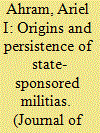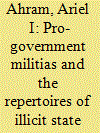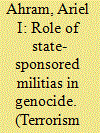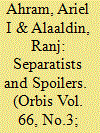|
|
|
Sort Order |
|
|
|
Items / Page
|
|
|
|
|
|
|
| Srl | Item |
| 1 |
ID:
144103


|
|
|
|
|
| Summary/Abstract |
In May 2015, the last border outpost between Syria and Iraq still controlled by the regime of President Bashar al-Assad fell to the mujahideen of the Islamic State.1 The Islamic State, also known as ISIS or ISIL, has long intended to erase what it claims are artificial boundaries, and to topple the ill-conceived states that mar the Arab world. It is not alone in that aim. From the Kurdish Democratic Union Party in Syria and Kurdistan Regional Government in Iraq, to the secessionist al-Hirak in southern Yemen and the Cyrenaican separatists in Libya, political actors across the region are mounting claims to states of their own. For the second time in a century, the map of the Arab world is on the brink of radical revision.
|
|
|
|
|
|
|
|
|
|
|
|
|
|
|
|
| 2 |
ID:
140357


|
|
|
|
|
| Summary/Abstract |
Following the 1990–91 Gulf War and the subsequent March 1991 uprising, the Iraqi government launched a brutal counterinsurgency campaign in the marshes of southern Mesopotamia. Alongside mass killing and forced population resettlement, the state used hydrological infrastructure to divert water from the wetlands, permanently desiccating the area. Using newly available Iraqi government archives, this paper argues that the destruction of the marshes was the result of a complex interplay between sectarianism, development planning, and security imperatives. Inhabited by peripatetic Marsh Arabs (Maʿdan), the marshlands stood out as an impenetrable wilderness. Baʿth policies in the marshes combined measures meant to promote social and economic modernization with counterinsurgency tactics meant to achieve control over the marsh region. After 1991, the regime set out to obliterate a terrain it deemed a strategic liability and a population that seemed an obstacle to modernization.
|
|
|
|
|
|
|
|
|
|
|
|
|
|
|
|
| 3 |
ID:
106793


|
|
|
|
|
| Publication |
2011.
|
| Summary/Abstract |
This article uses a sequential mixed method approach to examine the origins and persistence of paramilitaries and state-sponsored militias in the developing world. Combining comparative case studies of Southeast Asia and the Middle East with statistical analysis, it shows that revolutionary decolonization produces more decentralized and localized force structures, while direct inheritance of colonial armies leads to more conventional force structures. Subsequently, the level of competition within the regional system influences whether a state can persist in the use of paramilitaries or must transition to a more centralized, conventional force.
|
|
|
|
|
|
|
|
|
|
|
|
|
|
|
|
| 4 |
ID:
144871


|
|
|
|
|
| Summary/Abstract |
Most studies of pro-government militias (PGMs) take a narrowly functionalist approach. This article sees PGMs as the product of broader processes of state formation and regime dynamics that generate distinctive repertoires of violence. The article uses a cross-national dataset to shows that low state capacity is singularly correlated with the appearance and activity of all forms of PGMs. Once militias are active, they tend to endure even after initial conditions change, suggesting a strong measure of path dependence in how states PGMs evolve. Democracy curbs the activity of semi-official PGMs but not informal ones. Different authoritarian regime sub-types have varying propensities for militia activity. These findings have major implications for efforts to address state frailty.
|
|
|
|
|
|
|
|
|
|
|
|
|
|
|
|
| 5 |
ID:
132172


|
|
|
|
|
| Publication |
2014.
|
| Summary/Abstract |
This article explains how and why armed, non-state actors collaborate with states to inflict massive levels of violence. Regime type and state capacity interact to provide state elites a menu of repertoires for implementing violence, some emphasizing direct state action, others emphasizing cooperation and alliance between state and armed, non-state actors. Rather than struggling in vain to build strong states to eliminate armed non-state actors and establish a monopoly over the use of force, averting genocide might necessitate recruiting and strengthening the power of indigenous, armed non-state actors.
|
|
|
|
|
|
|
|
|
|
|
|
|
|
|
|
| 6 |
ID:
188136


|
|
|
|
|
| Summary/Abstract |
This article examines the United Arab Emirates’ (UAE’s) involvement in proxy warfare in the Middle East and the Horn of Africa. The UAE’s security posture in these volatile regions has evolved remarkably over the last two decades and set the Emirates apart from many of its rivals, peers, and neighbors, such as Qatar, Saudi Arabia, and Turkey. Most countries have intervened in conflicts in order to affect politics in the center, either by backing pro-government militias or center-seeking rebel groups. The UAE, in contrast, has constructed a portfolio of proxy relationships mostly with separatist groups. Such groups operate in far flung peripheral territories of countries like Yemen, Iraq, Syria, and Somalia. They do not seek to seize the state, but to break away from it. This approach to proxy warfare has granted the UAE unique negative control at relatively little cost. Through its proxy networks, the UAE can impede adversaries from consolidating control across the Indian Ocean littoral and maintain influence in the key maritime passages to Europe and Asia.
|
|
|
|
|
|
|
|
|
|
|
|
|
|
|
|
| 7 |
ID:
154043


|
|
|
|
|
| Summary/Abstract |
This article examines the interaction between territory, sovereignty, and statehood in the Middle East and North Africa. Various groups have aspired — and have failed — to become states since the contemporary regional system’s inception after World War I. Since the 2011 uprisings, movements claiming territory and sovereignty have emerged or become more viable throughout the region, including the Islamic State in Iraq and al-Sham (ISIS), Rojava, Cyrenaica, Azawad, and the Kurdistan Regional Government. Each poses different challenges to the regional system and holds out different hopes for rectifying historical missteps in state-building.
|
|
|
|
|
|
|
|
|
|
|
|
|
|
|
|
|
|
|
|
|